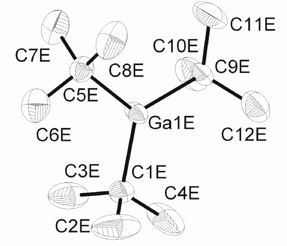Organometallic complexes of group 13 metals (Al - Tl)
Organometallic complexes of group 13 metals (Al - Tl)
This specific class of compounds has a long-known history in main group element chemistry. Many compounds have been prepared in the past and their structures and reactivities have been studied in detail. However, novel class of substituents such as sterically demanding terphenyl groups have been developed in the last decade, yielding novel group 13 organometallic compounds. These are valuable starting reagents for so far unknown complexes.
Me3M and Mes3M (M = B - Tl) are the only group 13 organometallics, which have been completely structurally characterized.[1] In contrast to the trimesityls, the solid-state structures of the trimethyls differ significantly. BMe3 is monomeric and adopts the expected D3h symmetric geometry,[2] however, the molecules pack in layers through weak van der Waals or electrostatic interactions to a closed packed array. AlMe3 forms a well-known dimer with bridging Me groups (also in the gas phase), whereas GaMe3, InMe3 and TlMe3 form two dimensional networks build by tetrameric units of MMe3.[3] The latter are formed through weak intermolecular metal×××Me interactions with long metal×××C bond distances. The tetramers are connected to each other by even longer metal×××Me bridges yielding two-dimensional networks. Interestingly, among the tetragonal phase a second polymorph of GaMe3, a monoclinic phase, in which the tetramers are replaced by a polymeric chain, was described. The solid-state structures of Et3Ga and t-Bu3Gawere also determined. Et3Ga consists of layers of wavelike networks build by four independent molecules in the unit cell. The Ga atoms interact to neighboring methylene and methyl carbon atoms. The intermolecular Ga×××C distances range from 308.7 to 359.3 pm. The wide Ga-C-C bond angle (113.3(2) - 118.8(2)°), which is comparable to that observed in solid BEt3 (118.7 - 119.3°), was explained by hyperconjugation of the gallium p-orbital into C-H orbitals. These intermolecular interactions are typically weaker or even suppressed by using sterically demanding organic substituents monomeric (kinetic stabilization). For instance, t-Bu3Ga crystallizes with six independent molecules in the asymmetric unit.[4] Five of the six independent t-Bu3Ga molecules show weak contacts to adjacent t-Bu3Ga molecules with Ga–C bond distances ranging from 3.2 and 3.6 Å, whereas only one t-Bu3Ga molecule remains uncoordinated. The intermolecular interactions result in molecules which slightly deviate from exact trigonal planar environment (357.5 - 359.5°). Compared to the gas phase structure of t-Bu3Ga (Ga–C 203.4(2) pm; C–Ga–C 120°), the average Ga–C bond length observed in the solid state is slightly shorter.
References
[1] a) J. F. Blount, P. Finocchiaro, D. Gust, K. Mislow, J. Am. Chem. Soc. 1973, 95, 7019; b) , M. M. Olmstad, P. P. PowerJ. Am. Chem. Soc. 1986, 108, 4235; c) J. J. Jerius, J. M. Hahn, A. F. M. M. Rahman, O. Mols, W. H. Ilsley, J. P. Oliver, Organometallics 1986, 5, 1812; d) O. T. Beachley, Jr., M. R. Churchill, J. C. Pazik, J. W. Ziller Organometallics 1986, 5, 1814; e) J. T. Leman, A. R. Barron, Organometallics 1989, 8, 2214; f) J. Blumel, B.; Werner, T. Krauter, B. Neumüller, Z. Anorg. Allg. Chem. 1997, 623, 309.
[2] R.; Boese, A. J. Downs, T. M. Greene, A. W. Hall, C. A. Morrison, S. Parsons, Organometallics 2003, 22, 2450.
[3] a) McGrady, G. S.; Turner, J. F. C.; Ibberson, R. M.; Prager, M. Organometallics 2000, 19, 4398; b) N. W. Mitzel, C. Lustig, R. J. F. Berger, N. Runeberg, Angew. Chem., Int. Ed. Engl. 2002; 41, 2519; c) Blake, A. J.; Cradock, S. J. Chem. Soc. Dalton Trans. 1990, 2393.
[4] A. Kuczkowski, S. Schulz, M. Nieger, Appl. Organomet. Chem. 2004, 18, 244.

